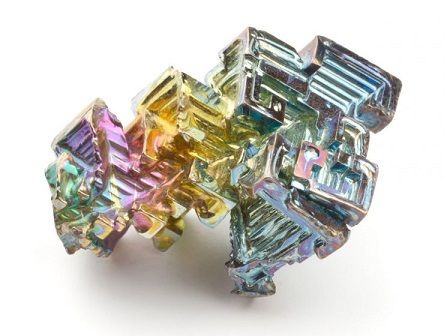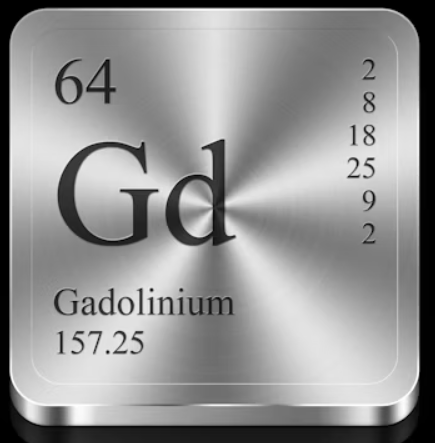Discovery and Major Minerals of Bismuth
Bismuth's Name
The name bismuth originates from around the 1660s and is of ambiguous etymology. It is one of the first 10 metals to have been found. Bismuth appears in the 1660s, from obsolete German Bismuth, Wismut, Wissmuth (early 16th century); possibly associated with Old High German hwiz ("white"). The New Latin bisemutum (because of German Humanist scholar and one of the leading experts on mineralogy and metallurgy Georgius Agricola, who Latinized many German mining and technical terms) is from the German Wismuth, perhaps from weiße Masse, "white mass." The element was often mistaken in early times for tin or lead due to its similarity to these elements.
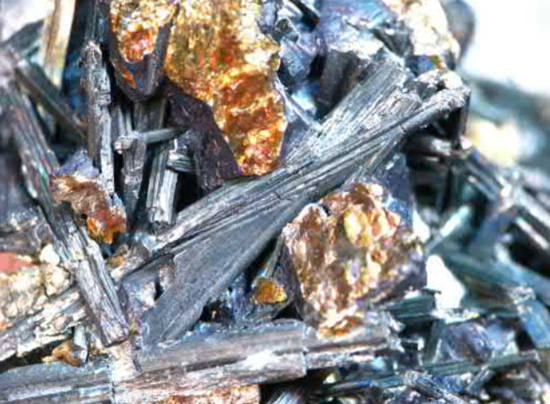
Figure 1. Steely gray, long bladed crystals of bismuthinite, Bi2S3, to 1.5 cm associated with chalcopyrite, CuFeS2.
What People Know about Bismuth
Bismuth has been recognized since ancient times, so its discovery cannot be attributed to a single person. Agricola, in his De Natura Fossilium (Agricola, 1546) wrote that bismuth is a distinct metal in a family of metals including tin and lead. This was based on study of the metals and their physical properties. Miners in the period of alchemy also named bismuth tectum argenti, or "silver being made," in the sense of silver still in the process of being formed within the Earth. Starting with German chemist Johann Heinrich Pott in 1738, Swedish Pomeranian and German pharmaceutical chemist Carl Wilhelm Scheele and Swedish chemist and mineralogist Torbern Olof Bergman, the difference between lead and bismuth became clear, and French chemist Claude Francois Geoffroy proved in 1753 that this metal is different from both lead and tin. Bismuth was also familiar to the Incas and utilized (together with the usual copper and tin) in a special bronze alloy for knives.
Major Minerals
In the Earth's crust, bismuth is about twice as abundant as gold. The most important ores of bismuth are bismuthinite (Bi2S3) and bismite (Bi2O3). Native bismuth is known from Australia, Bolivia, and China. The world mining production of bismuth in 2016 was about 10,000 tons, with the major contributions from China, Vietnam and Mexico.
Bismuth is mainly a by-product of extraction of other metals such as lead, copper, tin, molybdenum and tungsten. Bismuth stays in crude lead bullion (which can have up to 10% Bi) through a number of different refining steps, until it is removed by the Kroll-Betterton process (developed by Luxembourgish metallurgist William Justin Kroll) and patented in 1922.
Further improvements were developed by American metallurgist Jesse Oatman Betterton in the 1930s, through treatment with metallic calcium and magnesium. The resulting bismuth compounds have higher melting points and lower densities than the lead and can be removed as dross (a mass of solid impurities floating on a molten metal or dispersed in the metal. The term dross comes from the Old English word dros, meaning the scum produced when smelting metals). The compounds are treated with chlorine to free up the bismuth.
);You may like
Related articles And Qustion
See also
Lastest Price from Bismuth manufacturers
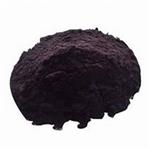
US $6.00/kg2024-09-19
- CAS:
- 7440-69-9
- Min. Order:
- 1kg
- Purity:
- 99%
- Supply Ability:
- 2000KG/Month
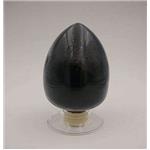
US $6.00/KG2024-09-13
- CAS:
- 7440-69-9
- Min. Order:
- 1KG
- Purity:
- 99%
- Supply Ability:
- 20TONS


